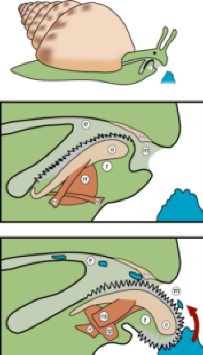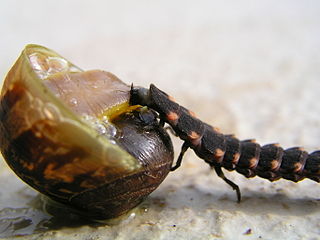Nutrition

How do snails
acquire their food?
Olfaction is the primary method of finding food for land
snails (NatureServe 2010). They use chemoreceptors, located on the lower two tentacles, to sample potential food (Dourson
2010). When the snail finds its prey it first uses its
foot to hold onto its food. Then the snail uses its radula to scrape
food into the mouth (Dourson 2010). Muscular contractions move
the food through the esophagus and mix it with saliva (Dourson
2010). Snails can feed anywhere from minutes to hours (Dourson 2010).
All
shelled gastropods require a large external source of calcium
carbonate to help keep their shells strong; they can get this from consuming limestone
(snail-world.com).
Diet of Fumonelix wheatleyi:
plants
decaying vegetation
leaf litter
wood/bark
fruiting bodies of fungi
When do snails eat?
Snails are nocturnal animals and prefer to feed during the
night up until early morning hours (snail-world.com). They consume more
food when it starts getting colder so they can store more fat for hibernation
during the coldest months (snail-world.com).
During the dry months of the summer, land snails can also voluntarily put their bodies into hibernation
mode to prevent starvation and to conserve energy (snail-world.com).
What eat snails?
Snails have very few predation mechanisms and are
very slow movers; this leads to snails being very easy targets for larger
predators (snail-world.com). Small predators of
land snails include beetles and leaches (snail-world.com). There are also many large
predators including: frogs, snakes, many kinds of birds, ducks and geese
(snail-world.com).

Humans are also one of the many predators of snails
(snail-world.com). Millions of snails are eaten
as a delicacy by humans annually (snail-world.com). The majority of snails that are consumed by people
are found in gardens, and considering Fumonelix wheatleyi is not a garden snail,
it has never been consumed by humans(snail-world.com).
Check out a predator of Fumonelix wheatleyi, the American Bullfrog!